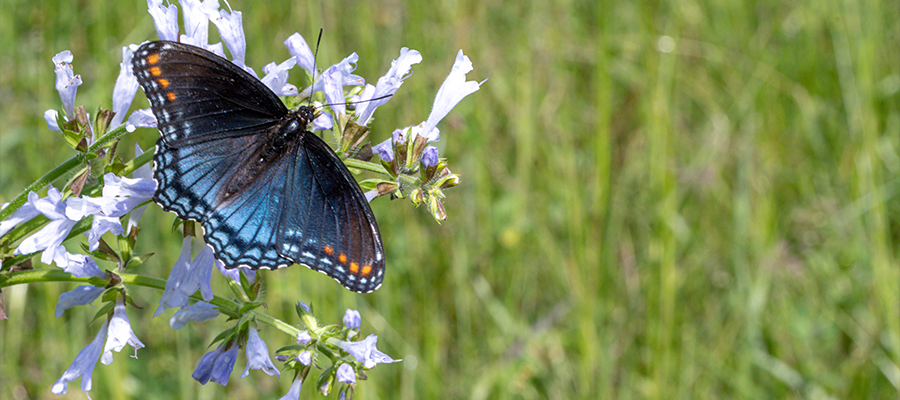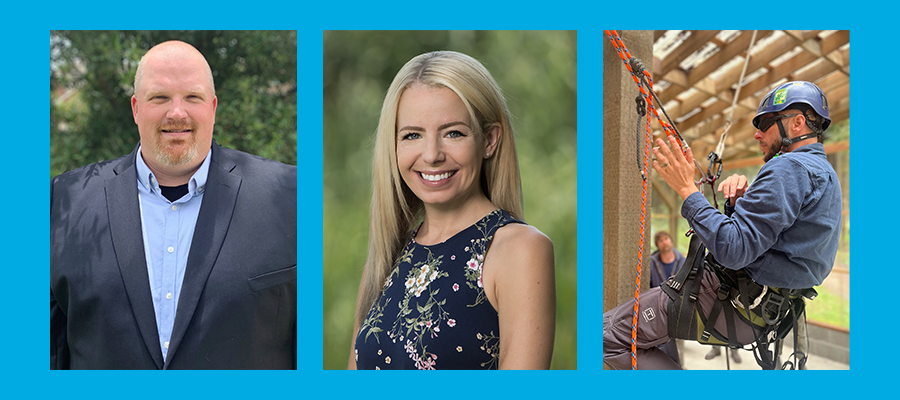- Vegetation Management Services
- In Your Neighborhood
- About
- Careers
- Webinars
- Articles
Climate Action Programs: Biodiversity Gains in ROWs Can Happen If We Think Big Picture

Climate Action Programs: Biodiversity Gains in ROWs Can Happen If We Think Big Picture
By Anand B. Persad, Ph.D., BCE, Director of Research, Science, and Innovation, ACRT Services
Climate action programs (CAPs) in our utility and transportation rights-of-way (ROWs) and corridors are becoming more and more required and entrenched in our day-to-day management strategies as we embrace the nuances of change in weather patterns, growing need for economic sustainability and post-pandemic worker challenges. As we continue to develop our ROWs, longer-term vegetation management plans, climate, humans, and economics will remain major governing aspects of our work in utility and transportation ROWs with a heightened focus on the intersection of utility and urban and natural spaces as we are called to a higher standard and bigger-picture approach.
A multidisciplinary approach helps with the big picture
Indeed, the ability to harness programs that can deliver on enhanced stewardship, biodiversity gains, and resilience in changing climate is now a priority for engaging in many of our social deliverables in and around the communities we serve. Added to these, is the need for sustainable ideals which can improve the outcome as we aim to reduce input and generate ecologically and economically favorable outcomes. The requirements of better understanding our ROWs — from soil to sky and everything in between — have never been more crucial in our integrated vegetation management (IVM) and vegetation management (VM) evolution and will only become more necessary as we brace for more erratic weather systems. Additionally, other high-impact factors may include the need for more aggressive invasive species counter efforts and improving our engagement in human-related aspects of our work; and most prominently will be safety challenges at an operational level as we are called to do more with sometimes lesser resources. However, opportunities abound for us to collectively draw on multi-disciplinary approaches and bridge our enhanced stewardship and sustainability goals with solid use of new and emerging technologies. Our focus on the ecological and economic return on investment (EROI) must embrace equally both tried and true, and emerging concepts and higher-order data management and analytics.
Metrics and branding aligned with biodiversity
One way to connect our soil-to-sky aspirations is to look at biodiversity in our CAPs and embrace the philosophy of “connected biodiversity.” I have long maintained the view that our end goals of sustainability and biodiversity gains are hitched closely to our in-house policies and planning that have now, to be effective, must be based on solid and defensible metrics.
Metrics are “not just numbers” — they must mean something aligned with our brand — everything comes down to how we as utilities, supporting agencies, and other institutions and departments can have meaningful inward-looking and outward-facing dialogue to communicate our management challenges and successes. Biodiversity metrics in our ROWs can enable a cohesive plan to come together and can demonstrate CAPs’ achievements over time — both gains and deficits. The use of audits while fragmented in the past must now be connected and aligned closely with our management strategies. On a positive note, several utilities including National Grid, have embraced the utilization of connected metrics, such as BIOaudit™. These are deployed over multiple cycles to draw business conclusions that are connected, data-informed, and meaningful for further use in planning. The larger picture emphasizes too that biodiversity metrics – a product of training, knowledge of ROWs systems, plant population assessments, and other ecological attributes come together nicely as a model for the future of many of our management operations on the ground, including pre- and post-construction, remediation of sites, rewilding of sites, etc.
The connection of biodiversity as a suitable result measurement tool (metric) to what happens during the process of IVM and VM rises in importance now as everything comes together and is packaged effectively to draw inherently from all contributing aspects and tasks.
Once a hard alignment to conceive, that of meshing safety, climate, and economics to biodiversity is now achievable as indices for each step, and contributing counter efforts to our challenges can now be assessed and rated over time and between cycles. Because our financial reporting is already closely aligned with management this piece comes together to deliver on our gains and return on investments.
The alignment of biodiversity metrics and cycles can be easily assimilated and generated in periodic reporting if suitable technology and software can be adopted to deliver these as needed sometimes in real-time scenarios enabling a more dynamic pivot and shift in management systems deployed as or if needed.
The rise of technology and the biodiversity and human interface
The use of rapid relay systems to help with the conversion of data to information will enable in addition to reporting, the ability to intercept and implement new strategies. As we pivot for example with erratic weather systems and the need for enhanced safety deployments, a faster response to change is needed. Technology can help and artificial intelligence (AI) tools are already a mainstay for many but will require us to adequately brace for the steep learning curve through effective training. For many personnel, this will be best met with effective and directed training programs that can then be applicable to adaptive research and real-world situations. Biodiversity does not occur in a vacuum and in our CAPs initiative and as we engage metrics and assessments, many of our related goals, such as vegetation-caused outage reporting become relatable, especially in cases of storm response and others such as remediation and post-construction re-canopy initiatives. The advent of AI-driven management tools coupled with advances in technology such as lidar and satellite do help with proactive determination of movement of assets and general program management. The human aspect of our CAPs is closely related to outcomes and challenges which may include worker retention and shortages may also be addressed with suitable technology adoption. This includes ready access to programs and software tools that can engage and stimulate workers and raise the profiles of task-doers who become more qualified and can showcase the ability to employ systems that can respond as shifts occur.
Corporate social responsibility (CSR), biodiversity, and communities
By far one of the most significant gains of connected biodiversity as a tool is for ecological (and economical) EROI delivery to our communities. The promise of a greener world and enhanced stewardship objectives is today a major criterion and performance index for a lot of green space managers in the utility world as well as in urban forestry as we implement CAPs. Our ability to showcase advancements and success to our neighbors and landholders in the area communities we serve is paramount in our CSR initiatives. Biodiversity reporting under this umbrella will only become more and more important as we engage with communities and can effectively narrate not only the good, we as IVM and VM managers are doing but also the good we will leave behind. Outward-facing dialogue with communities is just as important as getting the job done. Both inward and outward showcasing of our CAPs and biodiversity can be narrated via signage, newsletters, websites (e.g., bioaudit.acrt.com/national-grid), and other marketing materials such as infographics.
As we continue to embrace change and positively affect biodiversity levels, we as greenspace managers, collectively shoulder the responsibility to adapt. Our adoption of new technology, enhanced initiatives, and engagement of the human and social aspects of our work will ultimately reflect on the EROI we realize. By engaging in proper metrics and being able to pivot as needed our work becomes more dynamic and able to realize our goals more effectively. In conclusion, today as we think big picture, we need to train ourselves to adapt, engage spherically, and morph our strategies. We must remember that our legacy will be written in green.
Related Articles

By C. Troy Ross, President, ACRT and ACRT Pacific On a chilly Monday morning, a utility vegetation management crew gathers for their weekly briefing. Instead of launching into instructions, their supervisor begins by asking each team member how they’re doing. One mentions a child’s illness, another shares excitement about a certification course they just completed,[...]
Read More
By Aana Agrawal, Sustainability and Resilience Manager, EnviroScience The utility vegetation management (UVM) sector plays a crucial role in ensuring the smooth transmission of power across regions and cities by keeping plant growth under control within the vicinity of transmission and distribution lines. However, unrefined vegetation maintenance practices often focus on trimming, cleaning, and disposal[...]
Read More
By Ryan Meccage, Business Development Manager, ACRT Services In an age dominated by smartphones, constant connectivity, and algorithm-driven content, we’ve never been more digitally immersed. Yet somehow, we’ve also never felt so far removed from the natural world beneath our feet. The urge to step away from screens and re-establish a deeper connection with nature[...]
Read More
By Bob Urban, Senior Manager, ACRT Services In an industry where the stakes are high and every decision can have life-altering consequences, leadership in utility arboriculture isn’t just a managerial function; it’s a calling. Nowhere is this more evident than in the recipients of the Will Nutter Silver Shield Award, a recognition that honors frontline[...]
Read MoreRecent Posts
- Servant Leadership in Utility Vegetation Management 12th Nov 2025
- ACRT Pacific Honors Our Veterans 10th Nov 2025
- Rian Owens Receives Safety Challenge Coin 05th Nov 2025